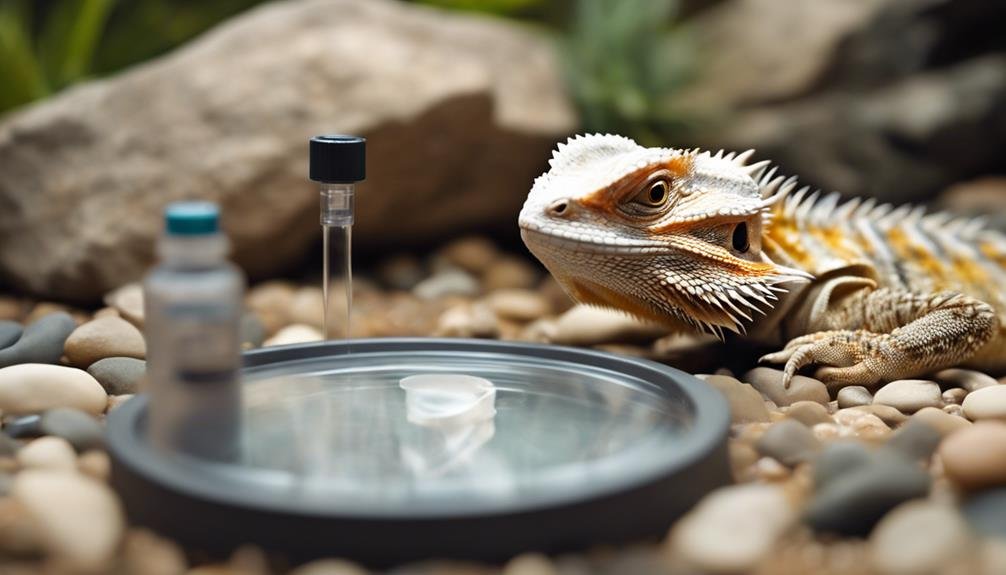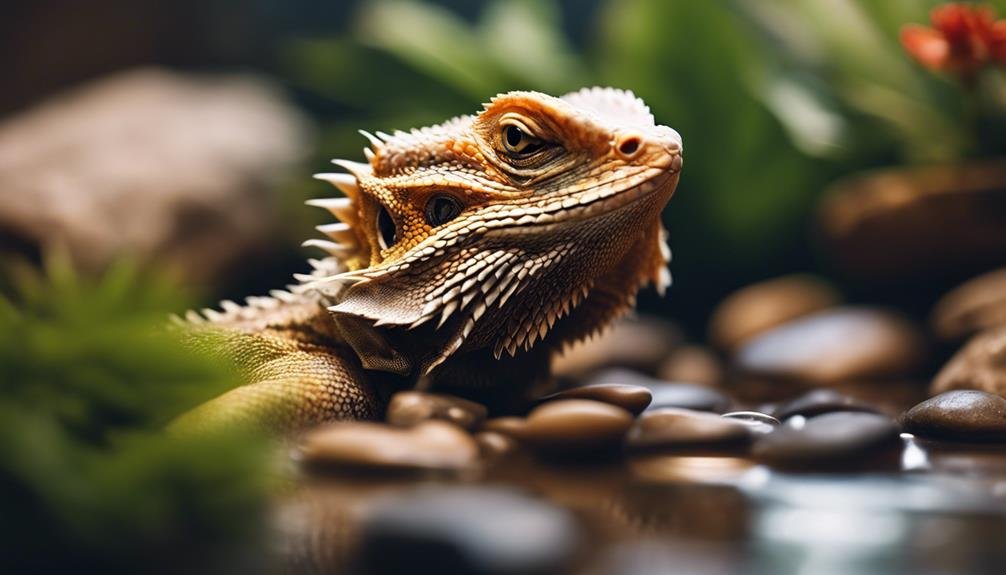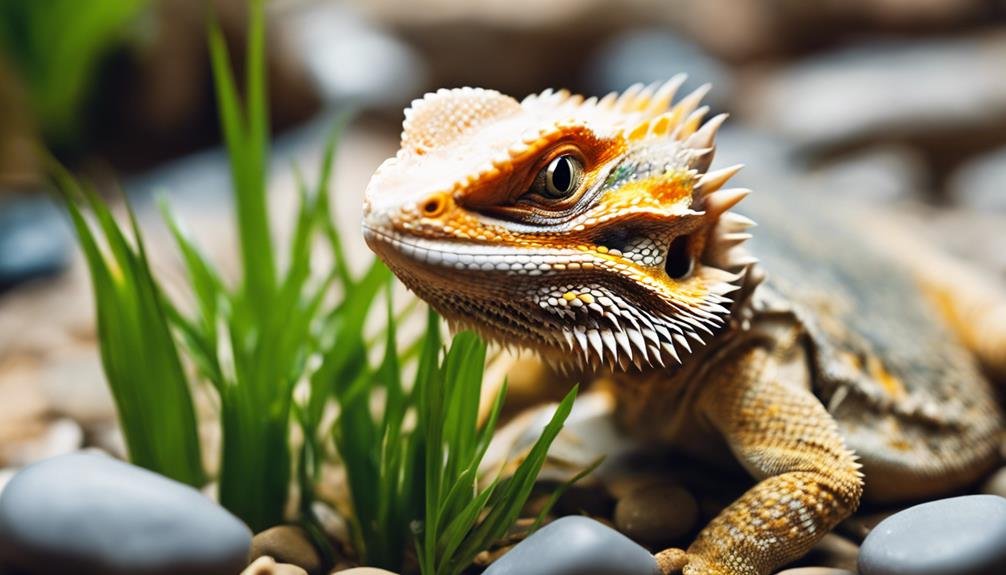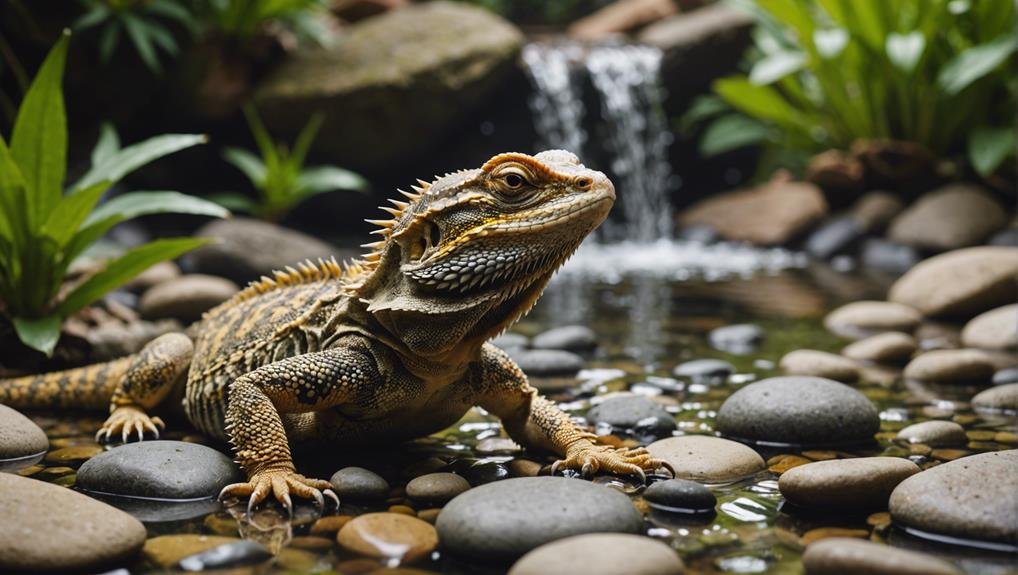As a bearded dragon owner, you might wonder if your scaly friend enjoys water-related activities. While it’s true that bearded dragons don’t typically encounter large bodies of water in their arid natural habitats, you’ll find that shallow water can offer them numerous benefits. Swimming and bathing can help in shedding and improve their hydration, not to mention the potential boost in their overall health. However, each dragon is unique, and their reactions to water can vary greatly. You might be surprised to learn how introducing water activities could transform your bearded dragon’s behavior and health. What signs should you look for to see if they enjoy these activities?
Key Takeaways
- Bearded dragons can swim and often enjoy water-based activities which engage different muscles.
- Bathing improves hydration and skin cleanliness and can boost mood and overall health in bearded dragons.
- Regular baths aid in shedding by loosening old skin and making it easier to remove.
- Water activities, including swimming, enhance bearded dragons’ muscle tone and cardiovascular health.
- Consistent exposure to water leads to increased activity levels and healthier, brighter skin in bearded dragons.
Understanding Bearded Dragons’ Water Needs


Bearded dragons need regular access to clean water to stay hydrated and healthy. As you care for your pet, it’s important to understand the best hydration methods to ensure they’re thriving.
Unlike other pets, bearded dragons might not drink from a water bowl regularly. To tackle this, try gently dripping water on their snout using a dropper or spray bottle. They’ll often lick the droplets, which helps keep them hydrated. This method mimics how they’d encounter water in the wild, often from dew or rain on plants.
You should also pay attention to environmental humidity. Bearded dragons come from arid habitats, so their enclosure should have low to moderate humidity levels, typically between 30% and 40%. High humidity can lead to respiratory issues and skin infections. Use a reliable hygrometer to monitor the moisture in their habitat.
If the air gets too dry, especially during winter when indoor heating can reduce humidity, consider using a room humidifier or misting their enclosure lightly. However, make certain the enclosure doesn’t become too damp. Keeping the balance right is key to their health and well-being.
The Swimming Behavior of Bearded Dragons
You might be surprised to learn that bearded dragons can swim, and many enjoy water-based activities. Despite their arid natural habitats, these reptiles exhibit natural behaviors that include swimming when given the opportunity. Watching your bearded dragon glide through water can be quite fascinating. It’s not just about splashing around; swimming is a complex activity that engages their muscles differently than walking or climbing.
When introducing your bearded dragon to swimming, consider using shallow outdoor pools. These settings mimic natural bodies of water and can make the experience more enjoyable for your pet. Guarantee the water is clean and chlorine-free to avoid any health issues. Initially, you might notice some hesitation, but with gentle encouragement, most bearded dragons grow to enjoy the activity.
Observe their behavior closely in the water. They should appear relaxed and curious, not stressed or struggling. If they seem uncomfortable, removing them from the water is important. Remember, each bearded dragon is unique, and while some may relish the chance to swim, others might prefer staying on dry land. Always respect their preferences and never force them to swim if they’re not willing.
Benefits of Bathing for Bearded Dragons


Regularly bathing your bearded dragon offers numerous health benefits, including improved hydration and cleaner skin. Immersing your pet in water not only helps to keep its skin free from dirt and debris but also provides an opportunity for it to absorb moisture. This is especially important as bearded dragons don’t drink frequently; bathing becomes an important hydration method.
The water also plays a significant role in preventing skin infections. Bearded dragons can accumulate bacteria and fungi on their skin, particularly in the folds. By bathing them, you’re washing away potential pathogens that could cause infections. It’s essential to ensure the water is lukewarm and clean to maximize these benefits without causing stress to your dragon.
Furthermore, a clean bearded dragon is a happy bearded dragon. Regular baths help maintain their overall health and can even boost their mood. Ensure you’re not overdoing it—too frequent baths can strip their skin of essential oils. Aim for a balance to keep your scaly friend healthy and content without the drawbacks of over-bathing.
Shedding: How Water Helps
Bathing your bearded dragon during shedding helps loosen and remove old skin more effectively. This process can be quite uncomfortable for your pet, and the right water interaction can greatly ease their discomfort. Submerging them in lukewarm water hydrates their skin and increases the overall humidity around them. This boost in humidity levels plays an important role in softening the old, stubborn layers of skin.
Skin hydration is particularly important during the shedding phase. Their skin can become dry and less elastic without adequate moisture, making the shedding process painful and patchy. This can lead to incomplete shedding, where patches of old skin cling to the new, potentially causing irritation or infection. By maintaining a routine of gentle baths, you’re ensuring that your bearded dragon’s skin remains supple and easier to shed.
Health Advantages of Water Activities


Engaging in water activities hydrates your bearded dragon’s skin and boosts their overall health through enhanced circulation and stress reduction. When you gently immerse your pet in water, you’re helping it cool down on a hot day and engaging in effective hydration methods that guarantee its skin remains supple and healthy. This is particularly critical during shedding periods when dry, flaky skin can become uncomfortable for your bearded dragon.
Moreover, bathing can greatly improve moisture retention, keeping your bearded dragon’s habitat in perfect humidity. This is essential for their well-being, as it aids in digestion and helps maintain their internal hydration levels. You’ll notice that with consistent water exposure, your bearded dragon might appear more active and display brighter skin, signs of a thriving pet.
Water activities also offer a form of gentle exercise that enhances muscle tone and cardiovascular health. They aren’t just splashing around; they are boosting their physical condition and metabolism. So next time you set up a bath for your bearded dragon, remember you’re not just cleaning them. With these simple yet impactful practices, you’re enhancing their health and potentially extending their lifespan.
Conclusion
So, you’ve discovered that your bearded dragon might just love the splash life! From swimming to bathing, introducing water activities can seriously boost their health and mood. It’s not just fun; it’s beneficial. Bathing helps with hydration, skin health, and easier shedding, while swimming can improve muscle tone and circulation. Give it a try, and you might see your scaly buddy perk up with brighter skin and more energy.
Immerse yourself in water play—it’s a win-win!


